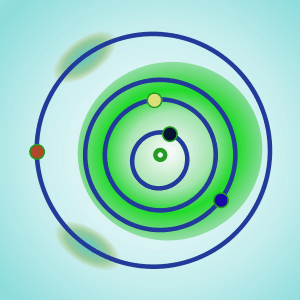1862 Apollo
|
A three-dimensional model of 1862 Apollo based on its light curve. | |
| Discovery | |
|---|---|
| Discovered by | Karl Reinmuth |
| Discovery date | April 24, 1932 |
| Designations | |
Named after | Apollo |
| 1932 HA | |
Apollo  Venus-crosser asteroid, Mars-crosser asteroid | |
| Orbital characteristics | |
| Epoch November 26, 2005 (JD 2453700.5) | |
| Aphelion | 2.294 AU (343.216 Gm) |
| Perihelion | 0.647 AU (96.850 Gm) |
| 1.471 AU (220.033 Gm) | |
| Eccentricity | 0.560 |
| 1.78 a (651.543 d) | |
Average orbital speed | 22.50 km/s |
| 38.337° | |
| Inclination | 6.355° |
| 35.777° | |
| 285.784° | |
| Physical characteristics | |
| Dimensions | 1.5 km (mean diameter)[1] |
| Mass | 5.1×1012? kg |
Mean density | 2.0? g/cm³ |
| 0.0005? m/s² | |
| 3? km/h | |
| 0.1277265 d (3.065436 h) | |
| Albedo | 0.25 (geometric)[1] |
| Temperature | ~222 K |
Spectral type | Q |
| 16.25 | |
|
| |
1862 Apollo /əˈpɒloʊ/ is a Q-type asteroid, discovered by Karl Reinmuth in 1932, but lost and not recovered until 1973. It is named after the Greek god Apollo.
It is the namesake of the Apollo asteroids, and the first one discovered, although because it was lost for a time its asteroid number (1862) is higher than that of some other Apollo asteroids such as 1566 Icarus. Analysis of the spin of this object provided observational evidence of the YORP effect.
It was the first asteroid recognized to cross Earth's orbit. It is also a Venus- and Mars-crosser asteroid.
Moon
On November 4, 2005, it was announced that an asteroid moon, or satellite of Apollo, had been detected by radar observations from Arecibo Observatory, Puerto Rico, October 29 – November 2, 2005. The standard provisional designation for this satellite is S/2005 (1862) 1. The announcement is contained in the International Astronomical Union Circular (IAUC) 8627 . The satellite is just 80 m across and orbits Apollo closely, in an orbit a mere 3 km in radius .
Potentially hazardous object
1862 Apollo is a potentially hazardous asteroid (PHA) because its minimum orbit intersection distance (MOID) is less than 0.05 AU and its diameter is greater than 150 meters. The Earth MOID is 0.0258 AU (3,860,000 km; 2,400,000 mi).[2] The orbit is well determined for the next several hundred years. On 17 May 2075 it will pass 0.0083 AU (1,240,000 km; 770,000 mi) from Venus.[2]
Further reading
- Durech, J.; Vokrouhlický, D.; Kaasalainen, M.; Weissman, P.; Lowry, S. C.; Beshore, E.; Higgins, D.; Krugly, Y. N. et al. (September 2008). "New photometric observations of asteroids (1862) Apollo and (25143) Itokawa – an analysis of YORP effect" (PDF). Astronomy and Astrophysics 488 (1): 345–350. Bibcode:2008A&A...488..345D. doi:10.1051/0004-6361:200809663.
See also
- Lost asteroid
References
External links
- (1862) Apollo in the Minor Planet Center's Database
- NASA JPL orbital simulation 1862 Apollo (Java)
| ||||||
| ||||||||||||||||||||||||||||
.png)